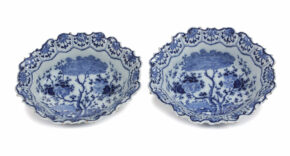
[popup_trigger id=”13756″ tag=”span”]![]() [/popup_trigger]
[/popup_trigger]
Images on this website are licensed under a
Creative Commons Attribution-NoDerivs 3.0 Unported License.
OBJECT
•D1209. Blue and Manganese Chinoiserie Posset Pot and Cover
Delft, circa 1700
Marked SVE T in blue for Samuel van Eenhoorn, the owner of De Grieksche A (The Greek A) Factory (1678-86)
The tapering cylindrical body affixed at the front with a tubular spout painted with a leafy shrub bisecting the otherwise continuous scene of a warrior with a pike, a lady standing before her attendant bearing a parasol, and on the reverse a dignitary seated among four other figures, two of them conversing and the third observing the fourth running away with a butterfly-shaped pennant, all amidst shrubbery continuing across the loop handles at the sides, the slightly sloping shoulder with a floral border repeated on the rim of the domed cover beneath a scene of two seated figures conversing amidst shrubbery around a mushroom-shaped knop painted on the top with a cinquefoil blossom.
Heights: 22.5 cm. (8 7/8 in. ); width: 28.5 cm. (11 1/4 in.)
Note: Posset pots are a form common to the Delftwares of both the Netherlands and England in the late seventeenth and early eighteenth century, although recipes for posset can be found in fourteenth- and fifteenth-century cookery books. As described by M. Archer, Delftware, The Tin-Glazed Earthenware of the British Isles, Victoria and Albert Museum (London 1997), p. 261, “posset, which was basically milk curdled with wine or other liquor, was taken either warm or actually hot… From the outset it had both a medicinal and a social function, depending on the particular mixture produced. It was [frequently given to mothers after childbirth as a restorative brew,] often taken as a soothing nightcap, or [it] could have a festive purpose. [Posset is recorded to have been] served at about midnight during a party given by Samuel Pepys on 6 January 1668, when it clearly
acted as a stimulant since his guests ‘went to dancing and singing again until two in the morning’. As the seventeenth century wore on, a wide variety of ‘fancy’ possets emerged. These came to include eggs, [sugar, cream, spices, occasionally fruits], and thickening ingredients such as barley, oatmeal, Naples biscuits and white bread. Such possets would have been eaten with a spoon and were increasingly served in basins, although the spouted posset pot would have allowed the consumer to suck up the liquor underneath the mixture without dipping his nose into the front at the top. By the eighteenth century the use of the posset pot was in decline as thickened possets took the place of ‘simple’, ‘plain’, ‘ordinary’ or ‘sack’ possets.”
AVAILABILITY
Sold








